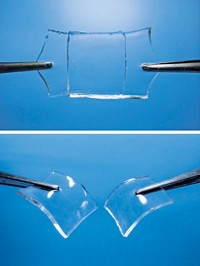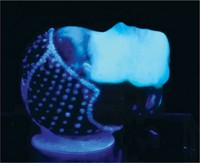Advertisement
Grab your lab coat. Let's get started
Welcome!
Welcome!
Create an account below to get 6 C&EN articles per month, receive newsletters and more - all free.
It seems this is your first time logging in online. Please enter the following information to continue.
As an ACS member you automatically get access to this site. All we need is few more details to create your reading experience.
Not you? Sign in with a different account.
Not you? Sign in with a different account.
ERROR 1
ERROR 1
ERROR 2
ERROR 2
ERROR 2
ERROR 2
ERROR 2
Password and Confirm password must match.
If you have an ACS member number, please enter it here so we can link this account to your membership. (optional)
ERROR 2
ACS values your privacy. By submitting your information, you are gaining access to C&EN and subscribing to our weekly newsletter. We use the information you provide to make your reading experience better, and we will never sell your data to third party members.
Materials
Coating Fixes Its Own Scratches
UV light helps replace broken cross-links in polyurethane
by Sophie L. Rovner
March 16, 2009
| A version of this story appeared in
Volume 87, Issue 11

IMAGINE YOU ACCIDENTALLY scratch your car's paint when you leave your garage in the morning. Now picture that paint repairing itself with the help of sunshine during your commute to work. That sort of application is the long-term goal of research that's just been reported by polymer scientists Marek W. Urban and Biswajit Ghosh of the University of Southern Mississippi (Science 2009, 323, 1458).
The paper describes a new self-repair approach for a polyurethane coating, says Nancy R. Sottos, a materials scientist at the University of Illinois, Urbana-Champaign.
Several self-healing compounds already exist. For example, Sottos and others have designed materials that release embedded healing reactants when cracked. Other researchers have produced materials in which "the crack-mending process is initiated by an external thermal-, mechanical-, chemical-, or photo-induced stimulus," she says.
The first photochemical repair of a polymeric material was reported by a Korean team (Chem. Mater. 2004, 16, 3982). The researchers produced their polymeric film by irradiating cinnamate monomers with UV light to form cyclobutane cross-links. Any cross-links subsequently broken by cracking could be fixed with another dose of UV light.
Urban says his own work differs by incorporating a minimal amount of a self-healing additive into polyurethane. He believes his technique could be broadly applicable because the additive could be incorporated into many other types of coating materials.
The researchers synthesized the additive by linking chitosan, a polysaccharide derived from crab and shrimp shells, to oxetanes, which are four-membered rings containing three carbon atoms and an oxygen. The additive also covalently bonds to the urethane polymers. When a scratch damages the material, exposure to UV light initiates a free-radical process that cross-links broken chitosan and oxetane fragments, repairing the damage in less than an hour.
So far, Urban and Ghosh have demonstrated the technique with microscopic scratches that are about 10 µm wide. Further work will be needed to show the strength of the repaired material and whether the technique can handle macroscopic scratches.





Join the conversation
Contact the reporter
Submit a Letter to the Editor for publication
Engage with us on Twitter